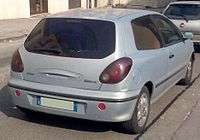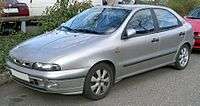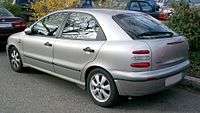Fiat Bravo and Brava
| Fiat Bravo Fiat Brava | |
|---|---|
 Fiat Bravo | |
| Overview | |
| Also called | Fiat Bravissimo (Japan) |
| Production | 1995–2001 |
| Assembly |
Cassino, Piedimonte San Germano, Italy[1] Bursa, Turkey (Brava only) Tychy, Poland[2] |
| Designer | Centro Stile Fiat (1992)[3] |
| Body and chassis | |
| Class | Small family car (C) |
| Body style |
3-door hatchback (Bravo) 5-door fastback (Brava) |
| Layout | FF layout |
| Platform | Fiat C1 |
| Related |
Fiat Marea Fiat Multipla |
| Dimensions | |
| Wheelbase | 2,540 mm (100.0 in) |
| Length |
4,020 mm (158.3 in) (Bravo) 4,190 mm (165.0 in) (Brava) |
| Width | 1,750 mm (68.9 in) |
| Height | 1,420 mm (55.9 in) |
| Chronology | |
| Predecessor | Fiat Tipo |
| Successor | Fiat Stilo |
The Fiat Bravo and Fiat Brava (Type 182) are small family cars produced by the Italian automaker Fiat from 1995 to 2001. They were effectively two versions of the same car, the Bravo a three door hatchback, and the Brava a five door fastback. The Bravo name was revived in January 2007, with the all new Fiat Bravo, a replacement of the Stilo. The new version was available only with five doors.
The name Brava was also used in the United States in the 1980s, on the earlier Fiat 131.
History




The Bravo and the Brava were replacements for Fiat's successful, but ageing Tipo model. The two cars were very different in styling detail and driving experience, the Bravo chassis being tuned for more precise handling, whilst the Brava was tuned for better comfort.
Even the interior trim and many of the body colours were unique to either one version or the other. Both cars had a two star safety rating on EuroNCAP. The cars came with all new engines, the base model using a 1.4 L twelve valve engine producing 80 PS (59 kW).
Three other petrol engines were available: the 103 PS (76 kW) 1.6 L 16 valve; the 113 PS (83 kW) 1.8 L 16 valve engine and the top of the range 2.0 L twenty valve inline five unit used in the HGT model, which produced 147 PS (108 kW) and which could take the car to a maximum speed of 213 km/h (132 mph), later in 1999, the 155 HGT model replaced the older model, power rising to 155 PS (114 kW).
Two turbodiesel engines were also available: both were 1.9 L four cylinder units, one producing 75 PS (55 kW) and the other making 100 PS (74 kW). The Bravo/Brava was voted European Car of the Year on its launch.[4]
In August 1996, the Bravo/Brava chassis spawned saloon and estate versions, badged Fiat Marea, a car which was aimed at Ford Mondeo and Opel/Vauxhall Vectra buyers, which won praise for its large boot.
Another car based on the Bravo/Brava underpinnings was launched in January 1999: the curious looking Fiat Multipla, a six seater compact MPV. In 1999, the Bravo/Brava received a mild makeover, and it was discontinued in October 2001, being replaced by the all new Fiat Stilo.
The cars were advertised as being silent, futuristic, economical and offering "The Choice". Fiat's Italian adverts said "Fiat Bravo. Fiat Brava. La Scelta." which roughly translates to "Fiat Bravo. Fiat Brava. The Choice", hinting to the fact that they're very similar cars but you can select between a sporty three door hatchback or a practical five door fastback. [5]
The Bravo and Brava were criticised as being a bit "futuristic" for their time, some reviewers really liked the way they looked, while others thought they were a bit odd.
Peter Davis, Fiat's Styling Center director at the time, said that they started working on the Bravo and Brava right after they had finished working on the Coupe and the Barchetta, so they had the steam built up. He mentioned that they wanted to push the design to the limit, break the rules and discover every angle of the car, distinguishing it from the competitors.[6]
Jeremy Clarkson reviewed the Fiat Bravo and Brava in 1995, on the old format of Top Gear, stating that "This is how an ordinary car can look like, if you put a bit of effort into it". He also stated : "I'm in a three door hatchback which you can buy for less than £10,000, and I'm having fun, and it's only got a 1.4 litre engine! A good looking car, that's nice to drive and cheap to run too."
He also mentioned that the car feels rigid, there are no squeaks or rattles, and all the switches inside have a quality feel.[7]
Makeover
The Bravo/Brava received a mild makeover in 1999.
The 1.4L 12v engine was dropped in favour of the 1.2 16v unit from the Fiat Punto, the 2.0L 20V engine of the HGT model gained VVT and VIS systems upping the power from 147 PS (108 kW) to 155 PS (114 kW), the dashboard was redesigned and improved across all trim levels, the grilles of the cars were redesigned, the A/C unit was swapped with the automatic one from the Fiat Coupé, and other small details about the cars were changed throughout the range of trims.
The 1.9 turbodiesel was phased out in favour of 1.9 JTD diesel units (now with and 105 PS or 77 kW), to give even better economy and refinement. In the Greek market, all later model Bravas received the rear deck spoiler as standard.
Special editions
- Anniversaire: introduced in 1997 for both cars, with only 1,100 pieces, celebrating Fiat's win of Car of the Year 1996 for the Bravo/Brava duo, for the Western Europe market. It was a 1.6 16v Sx version, with metallic paint, electrically adjustable and heated mirrors, fog lights, front passenger airbag, ABS and a CD player instead of the Tape player.
- Evening Vale: introduced in March 2000 for the Brava for the Western Europe market. It was a 1.2 16V/1.6 16V/1.9 JTD SX version, with special 14" wheel trims and automatic A/C.
- Formula: introduced in 2001, for the Bravo, for the United Kingdom. It was a 1.2 16V SX version with the GT Trim's 15" wheels, GT's rear spoiler, electrically adjustable and heated mirrors, fog lights, CD Player and remote central locking.
- Limited Edition: onwards from 2000, for the Hungarian market. Available for the 1.2 16V and 1.6 16V versions, it featured metallic paint, electrically adjustable and heated mirrors, fog lights, a passenger airbag and automatic A/C. The 1.6 16V also featured ABS.
- Special Edition: limited Edition, but only for the Bravo.
- Steel: last Bravo/Brava models, a "farewell" of October 2001 for the Western European market, before the duo was discontinued. Offered in 1.2 16v, 1.6 16v and 1.9 JTD Sx models, it featured Metallic Gray/Black/Blue paint, GT's 15" alloy wheels (Bravo) or Special 14" Wheel Trims (Brava), GT's rear spoiler, darkened rear lights (Bravo), "Steel" logo in the C column, electrically adjustable and heated mirrors, fog lights, passenger airbag, automatic A/C, CD Player, GT's steering wheel and shift knob wrapped in leather, two tone black/blue seats, white GT cluster and silver gt console and dash trim.
- Suite: available only for the 1.6/1.8/1.9 JTD Bravo GT for the Swiss market, in Blue or Black metallic colours, featuring special seven spoke 15" alloy wheels, the GT's rear spoiler, Suite logo in the C-Column, front passenger airbag, side airbags, electrically adjustable and heated mirrors, fog lights, automatic A/C, remote central locking, a high quality four speaker CD player with a CD Changer, GT leather wrapped steering wheel and shift knob, silver center console and dash trim and a full leather interior in cream, dark brown, dark blue or black.
- Trofeo: available only for the 1.2 Bravo Sx, for Western European markets, for 2000. Similar to the "Formula", it featured metallic Gray/Blue/Black/Sprint Blue/Sky Blue paint, GT's 15" alloy wheels painted with special gray paint, GT's rear spoiler, Trofeo written on the front wings, electrically adjustable and heated mirrors, fog lights, automatic A/C, GT's leather shift knob and steering wheel, white GT's cluster, silver center console and dash trim, blue/black two tone seats and door trim.
- Yellow: Hungarian 1.2 16v Sx Bravo, featuring the GT's alloy wheels, electrically adjustable and heated mirrors, fog lights and only available in a distinct yellow.[8]
HGT Abarth
In the end of 1999, Fiat introduced the Abarth accessories for the Bravo, available were more aggressive wheels and bodykit, performance was the same as the 2.0 HGT model. It was produced from 2000 to 2002.
Engines
| Model 1995:2003 | Engine | Displacement | Power | Torque | Note | 0-100km/h (Bravo - Brava) |
|---|---|---|---|---|---|---|
| Petrol engines | ||||||
| 1.4 S/SX | I4 | 1,370 cc | 80 PS (59 kW; 79 hp) at 6000 rpm | 112 N⋅m (83 lb⋅ft) at 2750 rpm | Until 1999 | 13.7s – 13.9s |
| 80 SX/HSX | I4 | 1,242 cc | 82 PS (60 kW; 81 hp) at 5500 rpm | 113 N⋅m (83 lb⋅ft) at 4250 rpm | From 1999 | 12.5s – 13.0s |
| 100 SX/HSX/ELX | I4 | 1,581 cc | 103 PS (76 kW; 102 hp) at 5750 rpm | 144 N⋅m (106 lb⋅ft) at 4000 rpm | – | 11.0s – 11.5s |
| 115 ELX/HLX/GT | I4 | 1,747 cc | 113 PS (83 kW; 111 hp) at 6100 rpm | 154 N⋅m (114 lb⋅ft) at 4400 rpm | – | 10.0s – 10.3s |
| HGT | I5 | 1,998 cc | 147 PS (108 kW; 145 hp) at 6100 rpm | 186 N⋅m (137 lb⋅ft) at 4500 rpm | Bravo only, until 1999 | 8.5s |
| 155 HGT | I5 | 1,998 cc | 155 PS (114 kW; 153 hp) at 6500 rpm | 186 N⋅m (137 lb⋅ft) at 3750 rpm | Bravo only, from 1999 | 8.0s |
| Diesel engines | ||||||
| 1.9 D SX | I4 | 1,929 cc | 65 PS (48 kW; 64 hp) at 4600 rpm | 119 N⋅m (88 lb⋅ft) at 2000 rpm | – | 17.8s – 17.8s |
| TD 75 SX | I4 | 1,910 cc | 75 PS (55 kW; 74 hp) at 4200 rpm | 147 N⋅m (108 lb⋅ft) at 2750 rpm | – | 15.1s – 15.5s |
| TD 100 SX/ELX | I4 | 1,910 cc | 100 PS (74 kW; 99 hp) at 4200 rpm | 200 N⋅m (150 lb⋅ft) at 2250 rpm | – | 10.8s – 11.0s |
| JTD 105 SX/ELX/GT | I4 | 1,910 cc | 105 PS (77 kW; 104 hp) at 4000 rpm | 200 N⋅m (150 lb⋅ft) at 1500 rpm | From 1999 | 10.4s – 10.6s |
| JTD 100 SX/ELX/GT | I4 | 1,910 cc | 100 PS (74 kW; 99 hp) at 4000 rpm | 200 N⋅m (150 lb⋅ft) at 1500rpm | From 2001 to 2003 | 10.4s – 10.6s |
Brazil
The Brava was produced until 2003 in Brazil for the home market and export, but in the former, the engines available were:
- Brava Sx/Elx 1.6 16v 106 PS (78 kW)
- Brava HGT 1.8 16v (127 PS (93 kW) or 132 PS (97 kW))
References
- ↑ "Fiat Press Information". Bravo-guide.co.uk. Retrieved 12 November 2008.
- ↑ 10 million vehicles produced in the former FSM and Fiat Auto Poland factories
- ↑ "MEGANE, BRAVO COMPTE A REBOURS POUR UN DOUBLE LANCEMENT". MEGANE, BRAVO COMPTE A REBOURS POUR UN DOUBLE LANCEMENT 18th September 1995.
- ↑ "Rewind to 1996: Fiat Bravo/Brava". Quicks. Archived from the original on 17 January 2014. Retrieved 23 January 2014.
- ↑ https://www.youtube.com/watch?v=flgNCrXaeA0
- ↑ https://www.youtube.com/watch?v=jPi1CtWncKw
- ↑ https://www.youtube.com/watch?v=jPi1CtWncKw
- ↑ http://www.fiatbravo.hu/leirasok/view.php?id=96
External links

